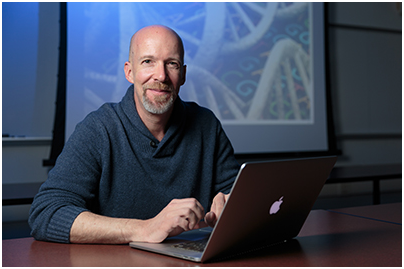Brian R. King

As a doctoral student, Brian King took a data-mining class that changed the trajectory
of his career. A professor involved him in a research project with the Cancer Research
Center at SUNY–Albany that introduced him to the field of bioinformatics.
Bioinformatics, an interdisciplinary field linking biology and computer science, intrigued King, now a professor of computer science & engineering. "I wanted to do something more than write programs — something that would benefit all of us," he explains. "This field gave me strong motivation as I realized that computer scientists are an integral piece of the puzzle that might eliminate diseases."
The project King worked on analyzed protein sequence data. Specifically, he developed models that related the sequence to the structure or function of a protein. Not long after he began work on the project, he developed a new analytical method that surpassed the existing method of his advisor. "My professor ended up hiring me to continue the research, and that set the whole path for my dissertation," King recalls.
Today King influences his own undergraduate students in much the same way, involving them in ongoing research projects that have several already co-authoring papers and posters. In his teaching, King stresses the importance of collaboration. "Interdisciplinary opportunities represent the real world today," he says. "My research gives every one of my students the opportunity to work with others outside of the computer science domain."
Several projects King and his students are working on involve a partnership with Geisinger's Autism & Developmental Medicine Institute. One is the development of an application that can help autistic children with speech impairments. The app uses a "word prediction model" that analyzes sequences of words that are most often spoken by children. The picture-based app gives nonverbal autistic children the voice to articulate what they need.
"We needed to develop a good, engaging user interface for these children," says King. "There are picture-based icons to represent toys, food, family members — the most common things a child would say. Though the child sees mostly images, my word prediction model is at the heart of the app. We will vary the level of words displayed behind the images, allowing it to work well with very young children as well as older children."
Another student is working with King in a partnership with Geisinger Medical Center to develop a large-scale map of genetic variants that are related to neurological disorders.
"All the projects are different," says King, "but they're all impacting humanity by analyzing a sequence of data."
Updated Sept. 30, 2016
